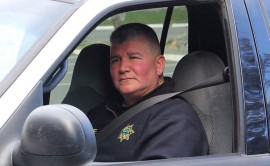
Jane judged drug addicts harshly until she became one in her late 20s. Suffering from depression and mourning a lifestyle she worked hard to maintain for her family, she began smoking meth. Three years into her addiction, she continues on a cycle of cleaning up and relapsing. She’s not sure what it takes to quit for good, but she knows she has to want sobriety more than anything else, more than the drug itself.
“There are good people who use drugs and there are bad people who use drugs,” she said. “Just like there are good people who don’t use drugs and bad people who don’t use drugs.”
Like so many living on the Hoopa Valley Reservation in California’s Humboldt County, Jane is a good person. She grew up with the love of both parents. But her childhood was far from easy. She waited in cars outside of bars and spent months at a time living with other family members while her parents entertained various addictions. Nonetheless she was raised to be a strong, productive member of the community. Even the strong succumb to meth.
Hoopa Tribal Police Chief Bob Kane sees it nearly every day. “How do you describe something that takes a sane person and turns them half insane?” he said.
The Hoopa Valley Tribe considers alcohol and controlled substances the most significant safety issue facing the community. They fear the greatest impact will be on the next generation—Hoopa’s at-risk youth.
The tribe’s court estimates that alcohol or substance abuse is a factor in approximately 65 to 70 percent of eviction cases heard by the court, and 75 to 80 percent of child-custody and divorce cases. In 2010 the court reported that alcohol or substance abuse was a significant factor in 80 percent of the child abuse and neglect cases heard on the reservation.
Not only does the community struggle with addiction, the people struggle to come together to address the problem. Last year the tribe applied for a grant through the Substance Abuse and Mental Health Services Administration (SAMHSA) that would help bring together their various organizations for a collective response to the problem. They didn’t get the grant, and funding continues to be an issue when providing substance abuse services to those in need. “The tribe’s approach has been focused on providing assistance to the already addicted person,” the tribal court wrote. “This approach has been utilized out of necessity: the limited staff resources have been used to try and put out the biggest fires in hopes of stabilizing individuals, their families and the community. It’s a crisis-driven system.”

Tribal Police Chief Kane has watched drugs sweep through the valley like a plague. (Jacob Simas)
The tribe’s system consists of a court, a juvenile probation program, a police department, an Indian Health Service clinic and a human services and mental health department. Human Services is where most people seeking help turn. Some say the department does not meet their needs, others say the opposite.
Tonya Bussell-Linderman works at Human Services as a substance abuse counselor. She also works under an alcohol and substance abuse prevention program that began in 2010. She said most of the people seeking services through Human Services are court ordered or on probation. The department facilitates intensive outpatient groups four days a week for two hours each day. “It’s intensive,” she said. “A lot of education and a lot of working on one’s self goes on there.”
It is estimated that Human Services serves about 550 people per year, many of whom access help for substance abuse–related problems. Although most arrive because of a court order, there are a few, like Jane, who walk in the door asking for help, either in a moment of desperation or planned self-intervention. Regardless, Bussell-Linderman said intake assessments are not done unless the individual in need has at least 24 hours clean and sober. Achieving 24 hours clean can be a real challenge for most suffering from an addiction.
Assessments are done as a way to identify the types of services a person may need. Assessments can also be used as a mechanism to track data about the problem in the Hoopa community. Because there are no inpatient treatment options in the local area, many referrals are made to the Friendship House in San Francisco and the Jordan Recovery Center in Crescent City.
All of Hoopa’s agencies working in the field agree there is a lack of support services and outpatient programs for those returning from treatment. “Our community needs more aftercare,” Bussell-Linderman said. “If we had places for people to go, sober living and clean and sober housing to support them, I think we would be more successful. They need to have a place that’s safe.”
Jane’s first trip to Human Services was an act of desperation. “Everything was falling apart. I was falling apart. I didn’t know what else to do or where else to go,” she said. Little did she know it would still be a while before she would be fully ready to walk the path to recovery.
She went with the intention of getting a quick ticket to rehab. Instead of immediate admission, the team at Human Services explained the steps she needed to take before checking into a program. Some treatment programs require as many as 30 days clean and sober to weed out those who are not serious about their recovery. Beds are hard to come by at any treatment facility. If a bed opens it’s usually filled within 24 hours.
Jane began to attend an intensive outpatient group at Human Services. Although Human Services calls it an intensive outpatient group, Jane feels it’s nothing more than a support group for people in recovery. Nonetheless, the staff at Human Services saw she was committed to recovery and began to take steps to help get into a treatment program. Within a month, a bed opened at a popular Native American treatment facility. Jane stayed a little over three weeks there before repacking her bags and heading home. She stayed clean for a year-and-a-half, and hasn’t quit working toward recovery on her own.
Recovery is about finding your higher power and maintaining that relationship,” said Jane. “Once you’ve found your higher

Clockwise from top left: Tonya Bussell-Linderman; Boyd Ferris, a leading member of the Sweat Hogs; Eva Smith; KTAC meeting (Jacob Simas)
power; with faith and belief you can do anything.”
Eva Smith, a medical doctor at the tribe’s Indian Health Service center, believes there is no recovery without spiritual recovery. She was also Jane’s medical doctor. “When people go away to treatment, they’re beginning to get in touch with some of the hurts and pain they have,” she said. “For a lot there’s a light switch that seems to go off about connecting to spirituality.”
The Sweat Hogs—a group of men in recovery from the Hoopa Valley—are finding that spiritual connection via a sweat lodge ceremony borrowed from the Great Plains tribes. The group comes together at least once a week to pray while drenching themselves in their own sweat. It’s a clean and sober sweat that serves individual spiritual needs while providing a network of support for participants, some young and some old.
Others on the reservation have found recovery in denominational churches, specifically the Shaker church—a unique blend of Christian denominations and Native American overtones.
Melodie George-Moore, a high school teacher and Hoopa ceremonial leader, also believes spirituality can be an important component to recovery. She explained that Hoopa ceremonies have long incorporated aspects of family medicine. “We have our traditions and old ways of healing,” she said. “And we do have our stories.”
George-Moore used an analogy to describe the impact substance abuse is having on the Hoopa community. “Drugs are attacking our family bonds. Think of a spider web and a central figure at the center of that web, and then the rays of the web coming from the center representing the various familial relationships,” she said. “Drugs come in and attack those family bonds—the rays of your web. The web is still there, but pieces are torn and that places pressure on the intact pieces of the web to do more.
“We all have this latent ability to build webs—to rebuild these relationships. It takes one person to activate another person,” she said. “The threads of the web are still there if people want to pick them back up.”
In 2010 a group of community members got together to try to help repair a community thread on the web. They named their organization the Klamath-Trinity Antidrug Coalition (KTAC). Initially meetings overflowed with anywhere between 40 to 50 participants. Some were frustrated with burglaries, others with law enforcement, more were frustrated with the lack of prevention activities available to deter youth from falling into the drug trap.
The group meets monthly and meetings have now dwindled to about five dedicated participants. Quarterly meetings are held every three months where local agencies are invited to give updates on law enforcement activities. KTAC is now working to organize a symposium for local schools and agencies to come together on prevention efforts.
As the community grows more and more frustrated with the problem, a cure can seem further out of reach. But people like Smith believe there is hope for the future. She has faith in the strength of Hoopa people. “There is a growing sense of intolerance that it’s not going to be okay anymore,” she said.
For Jane, recovery is slow. She’s struggling to get back into the community in a way people respect. “This community is so small and so impacted by drugs,” she said. “Staying clean is almost impossible. It’s in your face. It’s in your family. It’s in your family and your friends. It’s everywhere, and the community is one big judge. People begin to treat you differently and it’s difficult to establish yourself again.” 0
Additional reporting and photos by Jacob Simas
This article was originally published jointly by Two Rivers Tribune and New America Media, and is part of a series produced as a project for the California Endowment Health Journalism Fellowships, a program of USC’s Annenberg School for Communication and Journalism.